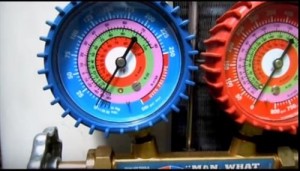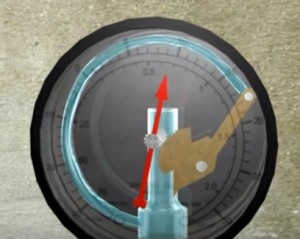
Probably the most often used tools in the service technician’s tool chest are gauge manifolds. A gauge manifold is comprised of a compound gauge, a pressure gauge, and the valve manifold.
All the service operations performed involving the refrigerant, lubricating oil, and evacuation can be accomplished by use of this tool.
Compound Gauges
These gauges are used to read pressures both above atmospheric and below atmospheric (vacuum). In practice, they are used to determine pressures in the low side of the system. The outside scale is in pressure (psig). The inside scales are the corresponding temperatures for different refrigerants.
Gauges operate from the action of a Bourdon tube. When pressure inside the Bourdon tube is increased, the element tends to straighten. As the pressure is decreased, the element tends to curve again. A Bourdon tube is a flattened metal tube sealed at one end. curved, and soldered to the pressure fitting on the other end. The movement of the element will pull a link that is attached to the pointer through a series of gears.

This movement will be shown by the gauge hand, or pointer. Compound retard gauges have a retarder that permits accurate readings within a given range. In refrigeration work this range would be between 0 and 100 gm.
These gauges can be recognized by the change in graduations at pressures higher than those usually encountered.
Pressure Gauges
Pressure gauges are used to determine pressures on the high side of the system. The outside scale is calibrated in psig, and the inside scales indicate the corresponding temperatures of the different types of refrigerants.
Some pressure gauges are not designed to operate at pressures below atmospheric pressure. Therefore, caution should be used duration evacuation procedures to prevent damage to these gauges.
Valve Manifolds
These manifolds provide openings through which the various service operations are performed on the refrigeration system.
The proper manipulation of the hand valves will permit almost any function. When the valves are screwed all the way in, the gauges will indicate the pressure on the corresponding line. The center line is usually connected to a vacuum pump, a refrigerant cylinder, or an oil container.
Charging Hoses
These hoses are flexible and are used to connect the gauge manifold to the system. Charging hoses are equipped with 1/4-in. (6.5 mm) flare connections on each end; some automotive units require a different size. One end usually has a valve core depressing attachment for attaching the gauges to schrader valves.* Charging hoses may be purchased in a variety of colors, which facilitate making the connections to the unit and are designed for a working pressure of 500 psi (3450.00 kPa) and an average bursting pressure of 2000 psi (13,800.00 kPa).